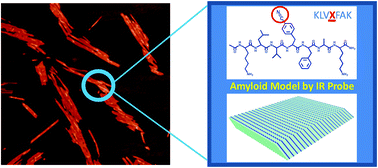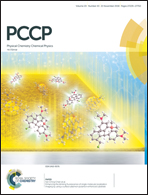A structural model of the hierarchical assembly of an amyloid nanosheet by an infrared probe technique†
Abstract
Rational design of amyloid-based materials requires structural insight into such materials. Here, we explore the use of a side-chain-based infrared (IR) probe technique combined with atomic force microscopy, Raman spectroscopy, UV-Vis spectroscopy, and thermogravimetric analysis coupled with mass spectrometry to elucidate the structural details of an amyloid nanosheet formed by an Aβ(16–22) variant, KLVXFAK, where X is p-cyanophenylalanine with its side-chain cyano group being an IR probe. Through the structural constraints obtained with the combined tools, we are able to propose a novel structural model for the amyloid nanosheet. The nanosheet can be viewed as a stack of class 7-type steric-zipper-like amyloid structures with a unique sheared intersheet arrangement: the β-sheets are stacked along a zippering axis with each individual β-sheet sheared relative to its adjacent β-sheets by two residues through the cyano–lysine intersheet hydrogen bond. With such a configuration, the side view of the nanosheet is similar to that of a stack of tilted-aligned roof tiles with each individual β-sheet being each tile. In addition, this work provides a nice example of how to utilize the side-chain-based IR probe technique combined with other supplemental tools to build a hierarchical structural model for a complex amyloid assembly.



 Please wait while we load your content...
Please wait while we load your content...